| |
|
Xiamen Oil Paintings, Wholesale Direct!
|
|
100% hand painted, 100% cotton canvas, 100% money back if not satisfaction. |
|
|
|
|
ART WORKS INDEX
A
B
C
D
E
F
G
H
I
J
K
L
M
N
O
P
Q
R
S
T
U
V
W
X
Y
Z
|
|
ARTISTS INDEX
A
B
C
D
E
F
G
H
I
J
K
L
M
N
O
P
Q
R
S
T
U
V
W
X
Y
Z
|
|
|
|
|
|
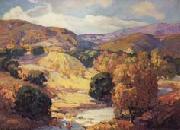 |
Franz Bischoff
|
|
Austrian-born American Painter, 1864-1929
was an American artist known primarily for his beautiful floral paintings and California landscapes. He was born in Bomen, Austria on January 9, 1864 and as a young teenager immigrated to the United States where he became a naturalized citizen. While in Europe, his early training was focused upon applied design, watercolor and ceramic decorations.After having lived and worked in New York, Fostoria, Ohio and Dearborn, Michigan, Franz Bischoff decided to visit California in 1900 and ultimately chose to settle in Los Angeles in 1906. Shortly after arriving, he started making arrangements to design and build a large Italian Renaissance style home in Pasadena that also became his studio. This landmark home was completed in 1908. Inspired by the California countryside, Bischoff set attempted to capture the area's brilliant light and diverse landscapes. Spending less time with ceramic painting, Bischoff painted local farms, fishing wharfs, and coastal landscapes. Recognized during his career for use of color and vivid composition, his paintings always displayed reverence for nature. One critic commented that some of his later works flirted with Expressionism and his use of colors were reminiscent of Fauvism.
|
|
 |
Franz Anton Maulbertsch
|
|
(June 7, 1724 -- August 8, 1796) was an Austrian painter and engraver, one of the most renowned exponents of roccoco painting in the German region.
Maulbertsch was born in Langenargen and studied in the Academy of Vienna. Through the knowledge of Paul Troger, he was influenced by the Venetian painters Piazzetta and Giovanni Battista Pittoni. He also studied the frescoes by Sebastiano Ricci in the Schönbrunn Palace in Vienna, and frequented Giambattista Tiepolo, who was active in Werzburg starting from 1750.
An appreciated frescoer, he received numerous commissions, mostly of ecclesiastical theme. He produced art for churches in Bicske, Kalocsa, Vienna's Michaelerkirche and Piaristenkirche Maria Treu. He also decorated the Porta Coeli in Moravia, the Kromeř Archbishop's Palace and the villa of Halbturn.
He also painted a portrait of Narcissus of Jerusalem
|
|
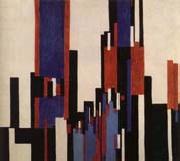 |
Frantisek Kupka
|
|
Czech Abstract Painter, 1871-1957,was a Czech painter and graphic artist. He was a pioneer and co-founder of the early phases of the abstract art movement and orphic cubism (orphism). Kupka's abstract works arose from a base of realism, but later evolved into pure abstract art. Frantisek Kupka was born in Opocno, eastern Bohemia (now Czech Republic). From 1889 to 1892, he studied at the Prague Art Academy. At this time, he painted historical and patriotic themes. In Kupka enrolled at the Akademie der Bildenden Kunste in Vienna, Vienna, where he concentrated on symbolic and allegorical subjects. He exhibited at the Kunstverein, Vienna, in 1894. His involvement with theosophy and Eastern philosophy dates from this period. By spring 1894, Kupka had settled in Paris; there he attended the Academie Julian briefly and then studied with Jean-Pierre Laurens at the Ecole des Beaux-Arts. Kupka worked as an illustrator of books and posters and, during his early years in Paris, became known for his satirical drawings for newspapers and magazines. In 1906, he settled in Puteaux, a suburb of Paris, and that same year exhibited for the first time at the Salon d'Automne. Kupka was deeply impressed by the first Futurist Manifesto, published in 1909 in Le Figaro. Kupka's 1909 painting "Piano Keyboard/Lake" marked a break in his representational style; his work became increasingly abstract around 1910 C11, reflecting his theories of motion, color, and the relationship between music and painting (orphism). In 1911, he attended meetings of the Puteaux group. In 1912, he exhibited at the Salon des Independants in the Cubist room, although he did not wish to be identified with any movement. Creation in the Plastic Arts, a book Kupka completed in 1913, was published in Prague in 1923. In 1931, he was a founding member of Abstraction-Creation. In 1936, his work was included in the exhibition "Cubism and Abstract Art" at the Museum of Modern Art in New York, and in an important show with another excellent Czech painter Alphonse Mucha at the Jeu de Paume in Paris. A retrospective of his work took place at the Galerie Manes in Prague in 1946. The same year, Kupka participated in the Salon des Realites Nouvelles, where he continued to exhibit regularly until his death. During the early 1950s, he gained general recognition and had several solo shows in New York. Between 1919 and 1938 Kupka was financially supported by his good friend, art collector and industrialist Jindich Waldes who accumulated a substantial collection of his art. Kupka died in Puteaux, France. Kupka had a strong interest in color theory; around 1910 he began developing his own color wheels, adapting a format previously explored by Sir Isaac Newton and Hermann von Helmholtz. This work in turn led Kupka to execute a series of paintings he called "Discs of Newton" (1911-12).
|
|
|
|
|
|
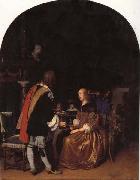 |
Frans van mieris the elder
|
|
Dutch Baroque Era Painter, 1635-1681
was a Dutch genre and portrait painter. The leading member of a Leiden family of painters, his sons Jan (1660-1690) and Willem (1662 C1747) and his grandson Frans van Mieris the Younger (1689 C1763) were also accomplished genre painters. Frans was the son of Jan Bastiaans van Mieris, a goldsmith, carver of rubies and diamond setter at Leiden. His father wished to train him to his own business, but Frans preferred drawing, and took service with Abraham Torenvliet, a glazier who kept a school of design. In his father's shop he became familiar with the ways and dress of people of distinction. His eye was fascinated in turn by the sheen of jewelry and stained glass; and, though he soon gave up the teaching of Torenvliet for that of Gerard Dou and Abraham van den Tempel, he acquired a manner which had more of the finish of the exquisites of the Dutch school than of the breadth of the disciples of Rembrandt. It should be borne in mind that he seldom chose panels of which the size exceeded 12 to 15 inches, and whenever his name is attached to a picture above that size we may surely assign it to his son Willem or to some other imitator. Unlike Dou when he first left Rembrandt, or Jan Steen when he started on an independent career, Mieris never ventured to design figures as large as life. Characteristic of his art in its minute proportions is a shiny brightness and metallic polish. The Music Lesson,National Museum of Serbia , BelgradeThe subjects which he treated best are those in which he illustrated the habits or actions of the wealthier classes; but he sometimes succeeded in homely incidents and in portrait, and not unfrequently he ventured on allegory. He repeatedly painted the satin skirt which Ter Borch brought into fashion, and he often rivalled Ter Borch in the faithful rendering of rich and highly-coloured woven tissues. But he remained below Ter Borch and Metsu, because he had not their delicate perception of harmony or their charming mellowness of touch and tint, and he fell behind Gerard Dou, because he was hard and had not his feeling for effect by concentrated light and shade. In the form of his composition, which sometimes represents the framework of a window enlivened with greenery, and adorned with bas-reliefs within which figures are seen to the waist, his model is certainly Dou.
|
|
|
|
|
|
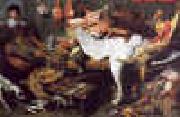 |
Frans Snyders
|
|
Belgian
1579-1657
Frans Snyders Gallery
Frans Snyders (1579 - 1657), or Snijders, was a Flemish painter of animals and still life.
Snyders was born and died at Antwerp. He is recorded as a student of Pieter Brueghel the Younger in 1593, and subsequently received instruction from Hendrick van Balen, the first master of Van Dyck. He was a friend of Van Dyck who painted Snyders and his wife more than once (Frick Collection, Kassel etc).
He became a master of the Antwerp painters guild in 1602. He visited Italy in 1608-9, visiting Rome, and working for Cardinal Borromeo in Milan. In 1611 he married Margaretha, the sister of Cornelis de Vos and Paul de Vos (another animal painter), in Antwerp. Jan Fyt was a student, and then assistant of his from 1629.
Snyders initially devoted himself to painting flowers, fruit and subjects of still life, but later turned to painting animals, and executed with the greatest skill and spirit hunting pieces and combats of wild animals. He was one of the earliest specialist animaliers.
Snyders and his wife, by Van Dyck, KasselHis composition is rich and varied, his drawing correct and vigorous, his touch bold and thoroughly expressive of the different textures of furs and skins. His excellence in this department excited the admiration of Rubens, who frequently employed him to paint animals, fruit and still life in his own pictures, and he assisted Jacob Jordaens, Thomas Willeboirts Bosschaert and other artists in a similar manner.
In the lion and boar hunts which bear the name of Snyders the hand of Rubens sometimes appears. He was one of the executors of Rubens's will.
He was appointed principal painter to the Archduke Albert of Austria, governor of the Low Countries, for whom he executed some of his finest works. One of these, a Stag-Hunt was presented to Philip III of Spain, who together with his successor Philip IV of Spain, commissioned the artist to paint several subjects of the chase, which are still preserved in Spain. He also worked for Archduke Leopold Wilhelm of Austria, when he became Governor.
|
|
|
|
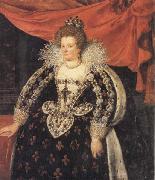 |
Frans Pourbus the younger
|
|
Flemish Baroque Era Painter, 1569-1622
was a Flemish painter, son of Frans Pourbus the Elder and grandson of Pieter Pourbus. He was born in Antwerp and died in Paris. He is also referred to as "Frans II". Pourbus worked for many of the highly influential people of his day, including the Brussels-based Spanish Regents of the Netherlands, the Duke of Mantua and Marie de' Medici, Queen of France. Works of his can be found in the Louvre, the Prado, the Rijksmuseum, the Royal College of Art, the Metropolitan Museum of Art and many other museums.
|
|
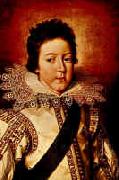 |
Frans Pourbus
|
|
Flemish Northern Renaissance Painter, ca.1545-1581
Painter, son of Pieter Pourbus. His work consists mainly of portraits and religious subjects, although he also executed a number of landscapes and history paintings. He worked mostly for the wealthy patrician class, and his work was instrumental in spreading the Romanism of Frans Floris (his teacher) throughout the Netherlands. It is probable that Frans Pourbus's earliest teaching was with his father in Bruges, but by 1564 he is recorded as working in the Antwerp studio of Floris. According to van Mander, Frans Pourbus and his fellow student Crispijn van den Broeck together completed an altarpiece by Floris after the latter's death in 1570. In 1566 Frans Pourbus married Susanna, a daughter of Cornelis Floris and niece of his master, and in 1569/70 he became a master in the Antwerp Guild of St Luke, though he retained his citizenship of Bruges. Gortzius Geldorp was his pupil in Antwerp in 1570. For Ghent Cathedral Frans painted Christ among the Doctors (the Viglius Altarpiece, 1571; in situ), which includes life-size portraits of Emperor Charles V, his son Philip, their secretary Viglius ab Aytta (d 1577), Jansenius, first Bishop of Ghent (d 1576), and the Duke of Alba. A decade later Pourbus executed the portrait of the Hoefnagel Family (c. 1581; Brussels, Mus. A. Anc.), shown grouped around a harpsichord playing musical instruments, in which the artist included a self-portrait (playing a lute) at the upper left. The picture was acquired in 1696 by Constantijn Huygens the younger from a cousin, a Hoefnagel descendant, in exchange for a horse; the young girl of 15 or 16 with a parrot in her hand was Huygens's grandmother. An inventory drawn up after Frans Pourbus death lists 20 portraits by him, many from the circle of the Duke of Anjou.
|
|
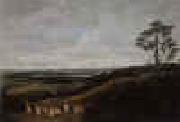 |
Frans Post
|
|
1612-1680 Dutch Frans Post Gallery
was a Dutch painter. He was the first European artist to paint landscapes of the New World.
In 1636 he traveled to Dutch Brazil at the invitation of Johan Maurits van Nassau-Siegen, who was governor-general there, at the suggestion of his brother Pieter Post. In 1644, Post returned to Haarlem. Of his Brazilian landscapes, some depict actual locations, while others are probably imaginary. Post's art is usually classified as Baroque.
|
|
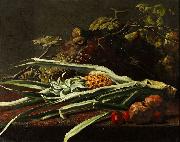 |
Frans Mortelmans
|
|
painted Still life with pineapple, grapes, apples and pomegranates in c. 1882
|
|
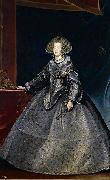 |
Frans Luycx
|
|
Frans Luycx.
Deutsch: Kaiser Ferdinand III. (1608-1657),
Brustbild.
Deutsch: um 1637/1638.
Medium. Deutsch.
|
|
|
|
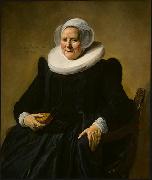 |
Frans Hals
|
|
1580-1666
Frans Hals Galleries
In the field of group portraiture his work is equalled only by that of Rembrandt. Hals's portraits, both individual and group, have an immediacy and brilliance that bring his sitters to life in a way previously unknown in the Netherlands. This effect, achieved by strong Baroque designs and the innovative use of loose brushstrokes to depict light on form, was not to the taste of critics in the 18th century and the early 19th, when his work was characterized as lazy and unfinished. However, with the rise of Realism and, later, Impressionism, Hals was hailed as a modern painter before his time. Since then his works have always been popular.
|
|
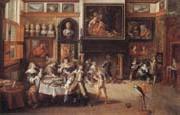 |
Frans Francken II
|
|
Flemish Baroque Era Painter, 1581-1642
was a Flemish Baroque painter and the best-known member of the large Francken family of artists. Many of his works are small historical, allegorical and biblical cabinet paintings with the focus on figures. He also invented or popularized several new themes that became popular in Flemish painting, such as genre scenes populated by monkeys (later imitated by David Teniers the Younger) and Kunstkamer paintings displaying a wealth of natural and artistic treasures against a neutral wall. Francken frequently collaborated with other artists, adding figures to works by Tobias Verhaecht and Abraham Govaerts.
|
|
|
|
 |
Frans de Momper
|
|
Flemish Baroque Era Painter, 1603-1660
Painter and draughtsman, nephew of (1) Josse de Momper II. In 1629 he became a master in the Antwerp Guild of St Luke. He left Antwerp for the northern Netherlands, working initially at The Hague; by 1647 he was in Haarlem and the following year Amsterdam, where he married in 1649. In 1650 Frans returned to Antwerp, where he painted numerous monochrome landscapes in the manner of Jan van Goyen. Paintings such as the Valley with Mountains (c. 1640-50; Philadelphia, PA, Mus. A.) prefigure the imaginative landscapes of Hercules Segers. The impression of vast panoramic spaces in Frans's work is adopted from his uncle's art. Frans executed a number of variations on the theme of a river landscape with boats and village (e.g. pen-and-ink drawing, Edinburgh, N.G.). In the late painting Landscape with a Ch?teau Encircled by Doves (Bordeaux, Mus. B.-A.), the low horizon and light-filled sky are adopted from the new Dutch school of tonal landscape painting, while the delicacy of the figures, feathery trees and buildings are features of the Italo-Flemish tradition exemplified by his uncle. Similar qualities of refinement and luminosity characterize the Winter Landscape (c. 1650; Prague, N.G., Sternberk Pal.),
|
|
|
|
 |
Frank Weston Benson
|
|
(March 24, 1862 - November 15, 1951) was an American Impressionist artist, and a member of the Ten American Painters.
Benson was born in Salem, Massachusetts. In 1879, he began study at the School of the Museum of Fine Arts, Boston under Otto Grundmann, and later at the Acad??mie Julian in Paris. Upon return to America, he would become an instructor at the School of the Museum of Fine Arts, Boston. Some of his best known paintings (Eleanor, Museum of Fine Arts, Boston; Summer, Rhode Island School of Design Museum) depict his daughters outdoors at Benson's summer home on the island of North Haven, Maine. He also produced numerous paintings and etchings of wildfowl.
Born into a successful merchant family, Benson lived in Salem for most of his life. At the Boston Museum school he befriended Edmund Charles Tarbell and Robert Reid, at the same time teaching drawing classes in Salem and painting landscapes during the summer. In 1883 he began his studies in Paris, and in the summer of 1884 painted at Concarneau, along with Willard Metcalf and Edward Simmons. His early paintings were conventional landscapes.
|
|
|
|
|
|
|
|
|
|
|
|
|
|
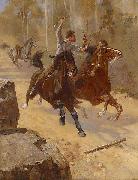 |
Frank Mahony
|
|
(4 December 1862 - 28 June 1916) was an Australian artist and member of the Dawn and Dusk Club.
Although christened "Francis Mahony", he later added 'Prout' and usually signed his work 'Frank P. Mahony'.
Mahony was born in Melbourne, third surviving child of Timothy Mahony, an Irish-born contractor, and his Cornish second wife Elizabeth, Johns. Mahony was taken to Sydney when 10 years old and studied at the Academy of Art under Giulio Anivitti.Mahony's work was accepted by The Bulletin and he became known for his excellent drawings of horses. In 1889 his oil painting Rounding up a Straggler, was bought for the Art Gallery of New South Wales; in 1896 The Cry of the Mothers was also purchased.Mahony did a lot of illustrative work for the Picturesque Atlas of Australia, Victoria and its Metropolis, the Antipodean and other magazines of the period, and was also responsible for some of the illustrations to Barcroft Boake's Where the Dead Men Lie.
|
|
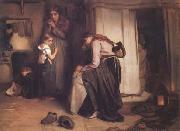 |
Frank Holl
|
|
1845-1888
Painter and illustrator. He received his first art instruction from his father, Francis Holl. At the age of 15 he entered the Royal Academy Schools, where in 1862 he was awarded a silver medal for drawing and in 1863 the gold medal for a religious subject, Abraham about to Sacrifice Isaac (untraced). In 1864 he exhibited two paintings at the Royal Academy,
|
|
|
|
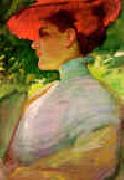 |
Frank Duveneck
|
|
1848-1919
Frank Duveneck Gallery
Frank Duveneck (October 9, 1848 ?C January 3, 1919) was an American figure and portrait painter.
Duveneck was born in Covington, Kentucky, the son of a German immigrant Bernard Decker. Decker died when Frank was only a year old and his widow remarried Joseph Duveneck. By the age of fifteen Frank had begun the study of art under the tutelage of a local painter, Johann Schmitt and had been apprenticed to a German firm of church decorators. While having grown up in Covington, Duveneck was a part of the German community in Cincinnati, Ohio. However, due to his Catholic beliefs and German heritage, he was an outsider as far as the artistic community of Cincinnati was concerned. In 1869 he went abroad to study with Wilhelm von Diez and Wilhelm Leibl at the Royal Academy of M??nich, where he learned a dark, realistic and direct style of painting. He subsequently became one of the young American painters ?? others were William Merritt Chase, John Henry Twachtman, and Walter Shirlaw ?? who in the 1870s overturned the traditions of the Hudson River School and started a new art movement characterized by a greater freedom of paint application.
|
|
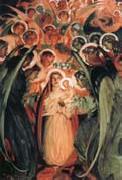 |
Frank Dumond
|
|
Landscapes, flowers, fishing scenes and portraits painter , Illustrator
American , 1865-1951
was an American impressionist painter born in Rochester, New York whose students included Norman Rockwell, Georgia O'Keefe, and Frank Mason. DuMond was a member of the Lyme Art Colony in Old Lyme,
|
|
|
|
|
|
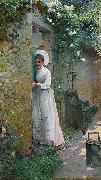 |
Frank Crawford Penfold
|
|
Frank (Francis) Crawford Penfold (1849-1921) was an American artist and teacher, remembered for his genre, landscape and portrait paintings, many of which he completed while living in Pont-Aven in Brittany.
|
|
|
|
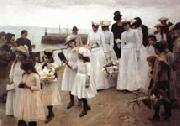 |
Frank Bramley
|
|
English Painter, 1857-1915
was a British post-impressionist painter of the Newlyn School. Bramley studied at the Lincoln School of Art from 1873 to 1878, later at the Royal Academy of Fine Arts Antwerp from 1879 to 1882. After staying in Venice from 1882 to 1884, he moved to the Newlyn School artist colony in Cornwall. Bramley worked on combining natural and artificial light in his paintings. His A Hopeless Dawn (1888) was bought by the Tate gallery. He married artist Katherine Graham in 1891.
|
|
|
|
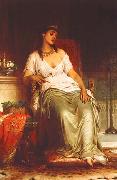 |
Frank Bernard Dicksee
|
|
(b. London, 27 November 1853 - 17 October 1928) was an English Victorian painter and illustrator, best known for his pictures of dramatic historical and legendary scenes. He also was a noted painter of portraits of fashionable women, which helped to bring him success in his own time.
Dicksee's father, Thomas Dicksee, was a painter who taught Frank as well as his brother Herbert and his sister Margaret from a young age. Dicksee enrolled in the Royal Academy in 1870 and achieved early success. He was elected to the Academy in 1891 and became its President in 1924. He was knighted in 1925, and named to the Royal Victorian Order by King George V in 1927.
Dicksee painted the piece 'The Funeral of a Viking' in 1893, which now resides in Manchester City Art Gallery, having been there since 1928 when it was presented by Arthur Burton ESQ in memory of his mother to the Corporation of Manchester. Victorian critics gave it both positive and negative reviews, for its perfection as a showpiece and for its dramatic and somewhat staged setting, respectively. The painting was used by Swedish Viking/Black metal band Bathory for the cover of their 1990 album, Hammerheart.
|
|
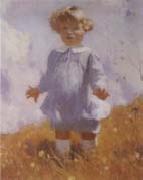 |
Frank Benson
|
|
American
1862-1951
American painter, etcher and teacher. He attended the School of the Museum of Fine Arts, Boston, from 1880 to 1883 as a student of Otto Grundmann (1844-90) and Frederick Crowninshield (1845-1918). In 1883 he travelled with his fellow student and lifelong friend Edmund C. Tarbell to Paris, where they both studied at the Acad?mie Julian for three years with Gustave Boulanger and Jules Lefebvre. Benson travelled with Tarbell to Italy in 1884 and to Italy, Belgium, Germany and Brittany the following year. When he returned home, Benson became an instructor at the Portland (ME) School of Art, and after his marriage to Ellen Perry Peirson in 1888 he settled in Salem, MA. Benson taught with Tarbell at the Museum School in Boston from 1889 until their resignation over policy differences in 1913.
|
|
|
|
|
|
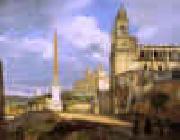 |
Francois-Marius Granet
|
|
1775-1849
French
Francois Marius Granet Gallery
French painter; student of J. L. David. Granet is known for his depictions of church interiors, among them his numerous versions of the Choir of the Capuchin Monastery, one of which is in the Metropolitan Museum. He bequeathed much of his own best work and also his fine collection of paintings to the museum of his native Aix-en-Provence.
|
|
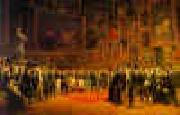 |
Francois-Joseph Heim
|
|
1787-1865
French Francois-Joseph Heim Gallery
He was born at Belfort. He early distinguished himself at the Ecole Centrale of Strassburg, and in 1803 entered the studio of Vincent at Paris. In 1807 he obtained the first prize, and in 1812 his picture of The Return of Jacob (Musee de Bordeaux) won for him a gold medal of the first class, which he again obtained in 1817, when he exhibited, together with other works, a St John-bought by Vivant Denon.
In 1819 the Resurrection of Lazarus (Cathedral Autun), the Martyrdom of St Cyr (St Gervais), and two scenes from the life of Vespasian (ordered by the king) attracted attention. In 1823 the Re-erection of the Royal Tombs at St Denis, the Martyrdom of St Laurence (Nôtre Dame) and several full-length portraits increased the painter popularity; and in 1824, when he exhibited his great canvas, the Massacre of the Jews (Louvre), Heim was rewarded with the Legion of Honour.
In 1827 appeared the King giving away Prizes at the Salon of 1824 (Louvre-engraved by Jazet) the picture by which Heim is best known and Saint Hyacinthe. Heim was now commissioned to decorate the Gallery Charles X (Louvre). Though ridiculed by the romantists, Heim succeeded Regnault at the Institute in 1834, shortly after which he commenced a series of drawings of the celebrities of his day, which are of much interest.
His decorations of the Conference room of the Chamber of Deputies were completed in 1844; and in 1847 his works at the Salon Champ de Mai and Reading a Play at the Theatre Francais were the signal for violent criticisms. Yet something like a turn of opinion in his favour took place at the exhibition of 1851; his powers as draughtsman and the occasional merits of his composition were recognized, and toleration extended even to his colour.
Heim was awarded the great gold medal, and in 1855-having sent to the Salon no less than sixteen portraits, amongst which may be cited those of Cuvier, Geoffroy de St Hilaire, and Madame Hersent he was made officer of the legion of honour. In 1859 he again exhibited a curious collection of portraits, sixty-four members of the Institute arranged in groups of four.
Besides the paintings already mentioned, there is to be seen in Notre Dame de Lorette (Paris) a work executed on the spot; and the museum of Strassburg contains an excellent example of his easel pictures, the subject of which is a Shepherd Drinking from a Spring.
|
|
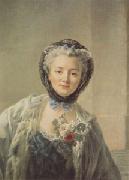 |
Francois-Hubert Drouais
|
|
Paris 1727-Rome 1775
was a French painter and Jean-Germain Drouais's father. He specialized in portraits, some of which include Louis XV's last two mistresses, Madame de Pompadour and Madame du Barry respectively. He even painted the young Marie Antoinette.
|
|
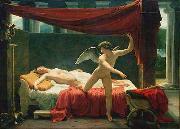 |
Francois-Edouard Picot
|
|
(10 October 1786 - 15 March 1868) was a French painter during the July Monarchy, painting mythological, religious and historical subjects.
|
|
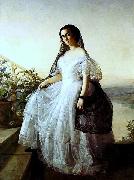 |
Francois-Auguste Biard
|
|
(June 30, 1799 - June 20, 1882) was a French genre painter.
Born at Lyon, he traveled around the world, sketching on the way. He was particularly successful in rendering burlesque groups.
His painting, Scenes on the Coast of Africa, depicted on the right, was the inspiration behind Isaac Julien's short film The Attendant (1993). Biard was a known abolitionist against the Atlantic slave trade.
Wikimedia Commons has media related to: Auguste François Biard
This article incorporates text from the public domain 1907 edition of The Nuttall Encyclopædia.
|
|
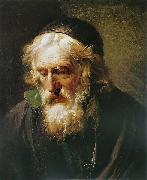 |
Francois-Andre Vincent
|
|
(December 30, 1746 - August 4, 1816) was a French neoclassical painter.
He was the son of the miniaturist François-Elie Vincent and studied under Joseph-Marie Vien. He travelled to Rome, where he won the Prix de Rome in 1768. From 1771 to 1775 he studied there at the Academie de France.
In 1790 Vincent was appointed master of drawings to Louis XVI of France, and in 1792 he became a professor at the Academie royale de peinture et de sculpture in Paris. In 1800 he married the painter Adelaïde Labille-Guiard.
Belisarius by François-Andre Vincent, painted 1776. He was a leader of the neoclassical and historical movement in French art, along with his rival Jacques-Louis David, another pupil of Vien. He was influenced by the art of classical antiquity, by the masters of the Italian High Renaissance, especially Raphael, and among his contemporaries, Jean-Honore Fragonard.
He was one of the founder members of the Academie des beaux-arts part of the Institut de France and the successor to the Academie royale in 1795.
|
|
|
|
|
|
|
|
|
| Wholesale China Oil Painting Wholesale Oil Painting China Xiamen Portrait Reproduction on canvas Chinese Oil Painting Wholesale USA Oil Painting |
|
|
|
|
|